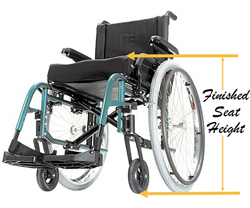Determining Wheelchair Seat Height

After seat width, wheelchair seat height is one of the most critical decisions that a user has to make when choosing wheelchair. Compromises may need to made based on the user's abilities and environment so determining the height that is most functional can be a bit challenging for some users.
Basic wheelchairs do not offer much choice in the height of the seat and will usually be around 19" or 20" high. Most lightweight and custom wheelchairs will allow some choice in seat height ranging from "super-low" (about 14") to "tall" (about 21").
Seat Height Issues
A height that is too low will create problems with foot rests dragging on the ground, limited access to tables and countertops, transfers and reaching items on higher shelves.
A height that is too high will make transfers into the wheelchair more difficult, may not allow the chair to be positioned up close to a table and can make picking up objects off the floor difficult.
Normal Seat Height
There is no such thing as "normal seat height" when it comes to wheelchairs.
Most regular seats and chairs will be around 18" or 19" high. This height usually allows most people to sit with their feet placed comfortably on the floor while being a good height for using a table or a desk.
Considerations
Ideally, wheelchair seat height will be about the same height as a regular chair for most users however there are other factors to consider:
- Footrests - Wheelchairs have foot rests that will hit the ground if the height is too low. The manufacturers have tried to address this problem by designing footrests so they position the feet further forward which in effect lifts the feet higher off the ground.
- Cushions - Most users use a wheelchair cushion which will add 1" to about 2 1/2" to the height of the wheelchair and the chair should be ordered a little lower to accommodate the added height. Note that the thickness of the cushion should be measured while it is compressed by the user's weight for an accurate measurement.
- User Height - Users with long legs will need a higher seat height to prevent their feet from dragging on the floor but users with short leg lengths may need a low seat height to be able to transfer onto or off of the wheelchair safely.
- Transfers - The height of the seat will affect the ability of the user to do transfers. If they are not able to do a standing transfer the surfaces they are transferring to (bed, toilet, couch etc.) should be close to the same height as the wheelchair's finished (with cushion) seat height.
- Foot Propulsion - Users who are not able to propel their wheelchair using their arms may use their feet for propulsion. These users must have their seat height low enough to plant their feet fairly firmly on the floor so they can pull themselves along. Propulsion is usually the most important factor for users and will usually supercede other height considerations.
As with other options when choosing a wheelchair, the height of the seat will involve compromises but as long as all the factors are considered a reasonable decision can be made.


 Online Vendors
Online Vendors  US Online Vendors
US Online Vendors 
